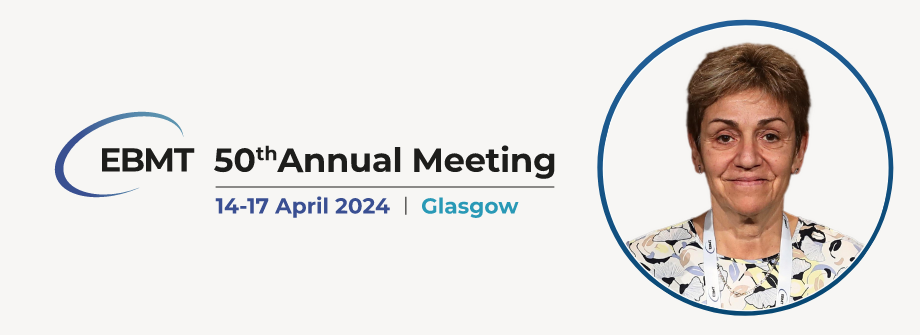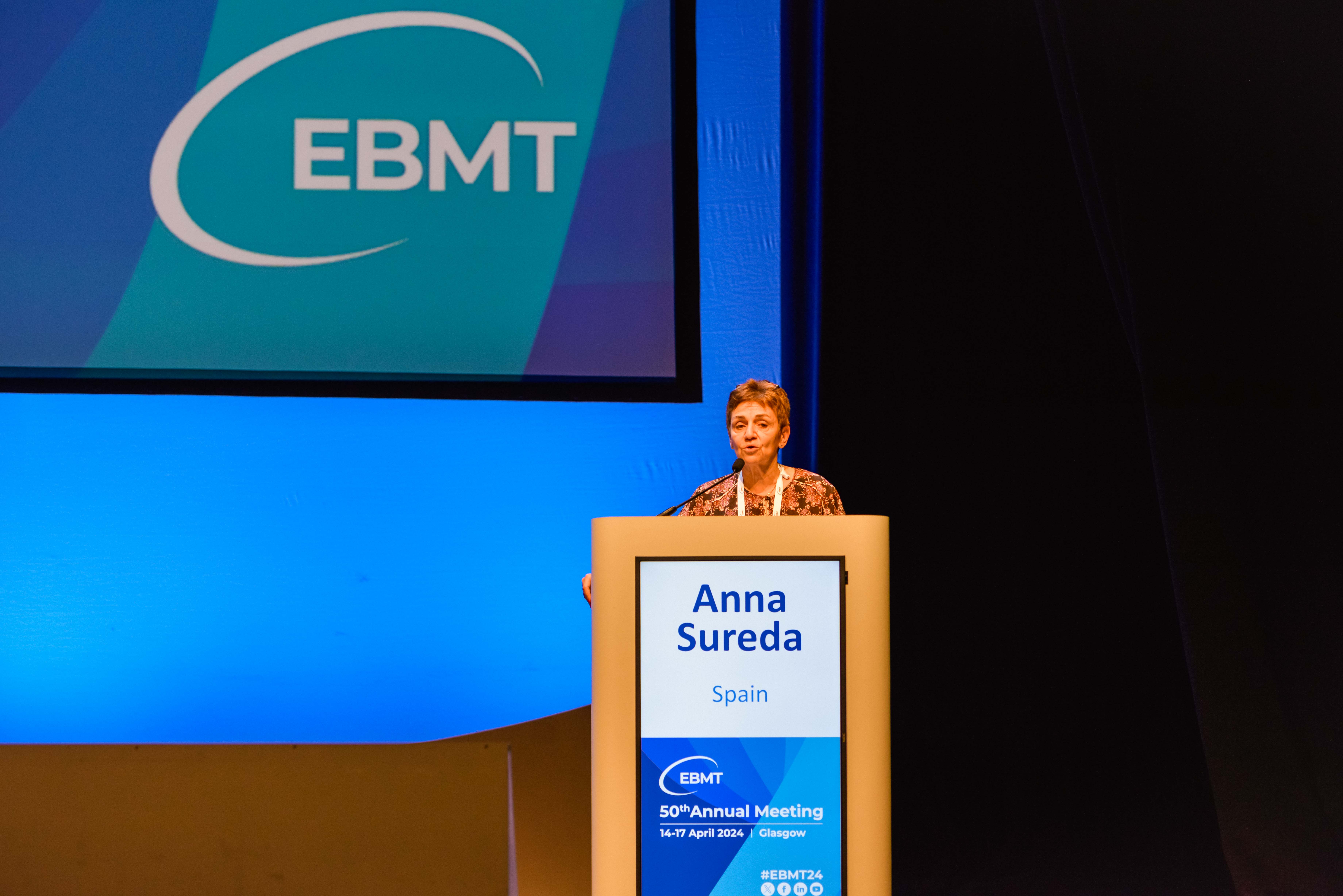
Anna Sureda
Head, Clinical Haematology Department, Catalan Institute of Oncology, Duran Reynals Hospital, Barcelona, Spain; President, Spanish Society of Hematopoietic Stem Cell Transplantation and Cellular Therapy (GETH-TC); President, EBMT.
Was there a particular person who inspired you to pursue your work in lymphomas and HCT?
Since becoming a resident in Haematology, I have always been intrigued by the pathophysiology and complexity associated with haematopoietic stem cell transplantation, both autologous and allogeneic, how to better understand complications after the procedure, and how to handle them. I have kept this interest throughout my professional life. With respect to the interest in lymphoma, the Head of the Department of the first institution I started to work in was very much interested in Hodgkin’s lymphoma, and he somewhat transmitted me the possibility to work in this specific field, which I also found very rewarding. After moving to Cambridge, UK, I opened my scope to both Hodgkin and non-Hodgkin lymphoma.
Having served in various leadership positions, peer-reviewed for numerous journals, and practiced in both Barcelona, Spain, and Cambridge, UK, where do you feel you gained the most valuable experience in your career to date?
I have learned from every single place I have worked in, and from every single position I have occupied. Professional challenges always bring positive experiences from my point of view, and the beauty is to be able to interiorly process them in order to use them to grow, not only from a professional point of view, but also from a personal point of view.
In this 50th year anniversary of the EBMT, how proud are you to be leading the organisation, as President, and what are you most looking forward to about the meeting in Glasgow, UK?
I am very proud to have had the opportunity to lead EBMT as a scientific society dedicated to stem cell transplantation and cellular therapy, and to the better understanding of these specific fields, with the objective of improving patient outcomes. I started as the chair of the Lymphoma Working Party (LWP) in 2004, and had never thought I was going to be able to occupy this position. The 50th anniversary will be a very special meeting for our society; we will be able to remember the past, but we will also be able to see what we have done up until now, and what we will be doing, or trying to accomplish, in the future. It will be a very emotional meeting, in which we will try to bring to all participants the cutting-edge investigations in the field of stem cell transplant and cellular therapy.
Over the course of your career, you have worked on multiple clinical investigations of novel therapies, such as combining immunotherapy and stem cell transplantation. What are the most significant advances you recall from your period working in haematology?
I have been working as a clinical haematologist for more than 30 years. When I started as a junior consultant, the treatment of our patients was only based on chemotherapy, with more or less intensity, and associated with radiotherapy, considering broader fields of irradiation, and higher doses, than we consider today. Over the past few years, we have tried more and more to offer personalised medicine to our patients in order to increase efficacy, decrease toxicity, and administer the exact amount of treatment that one individual patient deserves. We have done that with a better understanding of the biology of the different diseases, with data coming from the laboratory, and from clinical and basic scientists who have allowed us to better understand the treatments we are giving, as well as the prognostic factors. Last but not least, the introduction of new drugs, of targeted therapy, has the aim to increase efficacy of treatment, but also to decrease toxicity.
How important is the EBMT, and how is it positively impacting both clinicians and their patients?
EBMT represents the European umbrella for all clinicians, researchers, nurses, and the rest of healthcare professionals who are dedicated to stem cell transplantation, and other types of cellular therapies. EBMT has the patient in the centre of all the activities and, in this sense, EBMT also wants to represent patients, and patient groups, and incorporate them in all the different activities that the society is doing. EBMT wants to educate the new generation of physicians and nurses dedicated to transplantation and cellular therapies, and we have also integrated them into our life. EBMT follows the Equality, Diversity, and Inclusion (EDI) concept, and we want to be a society as inclusive and diverse as possible. All these concepts make EBMT a society with a clear impact in this field.
Could you speak about the new EBMT registry, and how this could prove a turning point in the provision of treatment across Europe?
The registry is one of the treasures, if not the biggest one, of EBMT. Since 1974, we have been collecting clinical characteristics and long-term outcomes of our patients treated with stem cell transplantation. Over the last few years, the registry has also been collecting data from patients treated with chimeric antigen receptor (CAR)-T cells. In February 2019, the EBMT registry received the positive opinion from the European Medicine Agency (EMA) on the use of its patient registry to collect real-world data on efficacy and toxicity of patients treated with commercial CAR-T cell constructs (Post-authorisation Safety [PAS] studies). The new registry platform went live in August 2023 and, from then on, centres are able to report data on patients using a more user-friendly platform. This will for sure facilitate the collection of this information, as well as its use for scientific analysis.
As a prolific author, co-authoring over 400 manuscripts, where can you see current gaps in the literature, and which areas within the field of blood and marrow transplant require the greatest attention?
In spite of the fact that the field of cellular therapy has seen significant advances in the past years, there are many additional gaps that we need to better analyse. We should continue working in personalising therapy, and giving each patient the type of therapy that they should receive. We need to decrease transplant-related mortality, and improve quality of life in our patients. We need to decrease the incidence of the major transplant-related complications (graft-versus-host disease and infections), and prevent relapse, the major cause of failure of the transplant that we still have in 2024. With the advent of CAR-T cells into the scene, it is important to better understand which types of patients are better suited to transplant, and which ones should better be treated with CAR-T cells; we need to fine-tune the best candidates for CAR-T, and improve preventive and treatment measures to decrease toxicity after CAR-T. We should also look more in depth at the translational and basic research, to better understand the clinical opportunities we can give to our patients. In summary, there is still a lot of work to be done in the future.

